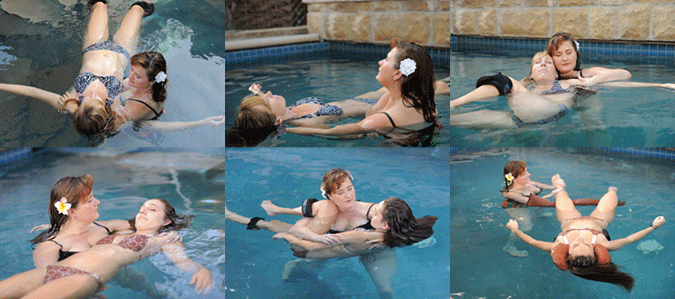
Watsu: (WATer
ShiatSU) is a form of aquatic therapy, which quiets the mind, relaxes the
body and opens the heart. It is a uniquely nurturing combination of massage, yoga-like stretches and point work carried out in skin temperature (96 degrees) water. The weightless environment of the
water allows for graceful, fluid dance-like movements which free the body and can assist the receiver in a deeply relaxing experience.
Benefits include increased range of motion, deeper breathing, emotional release, improved posture
and body awareness, bolstered self-esteem and aid with sleep and fatigue. Research shows us that moist warmth causes relaxation. The warmth of the water aides superficial circulation while its
buoyancy relieves the workload of painful joints. The client is free to be in a peaceful environment without distraction. Watsu is not only capable of reducing or eliminating pain, it can also
decrease muscle guarding and tension.
History
Watsu® means Water Shiatsu. It is a form of warm water body work pioneered by Harold Dull in the eighties after he studied with a Shiatsu master in Japan and brought
that art home to Harbin Hot Springs, a retreat/spa located in Middletown, CA. Dull integrated energy work, stretches and pressure point techniques with massage and added the fluidity of movement in
warm water to birth a new approach: Watsu®. David M. Morris, M.S. P.T. of Comprehensive Aquatic Therapy in Birmingham, credits Harold Dull with developing Water Shiatsu (Watsu®). "Dull describes the
technique as Zen shiatsu principles applied to people floating in the water. Watsu® was created as a wellness technique; it was not originally intended for patients with neurologic disorders.
Rehabilitation therapists have applied the approach to patients with a variety of physical disorders, however, and anecdotal reports indicate clinical success. Based on Eastern medicine theory,
Watsu® stretches to body's meridians (pathways of energy). Through stretching, these pathways are thought to be brought closer to the body's surface, where energy can be released. These effects are
enhanced by rotational movements that release blocked energy from joint articulations. As a completely passive recipient, the patient experiences profound relaxation from the water's support and the
continual, rhythmic movement that flows gracefully from one position to the next. The stretches comprise specifically described transitions and sequences of movement. In general, the therapist
stabilizes or moves one segment of the body while movement through the water, resulting in a drag effect, stretches another segment. Once the transitions and sequences are learned, therapists are
encouraged to vary them according to the needs and limitations of the patient." Aquatic Rehabilitation, by Richard Ruoti. Lippincot 1997.
What it is
Simply explained, Watsu® uses 92-96 degree water and a variety of stretches and gentle movements to relax the body and mind and allow them to release pain and stress.
The receiver floats on his back with ears underwater and eyes closed while being gently guided through a series of smooth movements by a practitioner. Movements vary from flexion to extension with
traction and rotation. Trust of the practitioner and surrender to the water are vital.
Benefits
Benefits include increased range of motion, deeper breathing, emotional release, improved posture and body awareness, bolstered self-esteem and aid with sleep and
fatigue. Research shows us that moist warmth causes relaxation. The warmth of the water aides superficial circulation while its buoyancy relieves the workload of painful joints. The client is free to
be in a peaceful environment without distraction. Watsu® is not only capable of reducing or eliminating pain, it can also decrease muscle guarding and tension. My personal experience in working with
a severely involved 7 year old with cerebral palsy has underlined this quality for me. Her decrease of spasticity took 45 minutes when we started to work together 18 months ago. Now she relaxes in 5
minutes. Watsu® practitioners see the benefits, but in our search for scientific explanations we're stymied. In a recent article in PT-OT-Speech Today, Andrea Saltzman, M.S. P.T. states, "After five
years of PT practice, (and almost four years of a purely aquatic practice), I find it is the rare asion that Watsu® is solely a matter of fluid mechanics. I find it stirs the patient's
soul."
For appointments: Cynthia Story at 805.729.2255
Santa Barbara ~ Montecito


